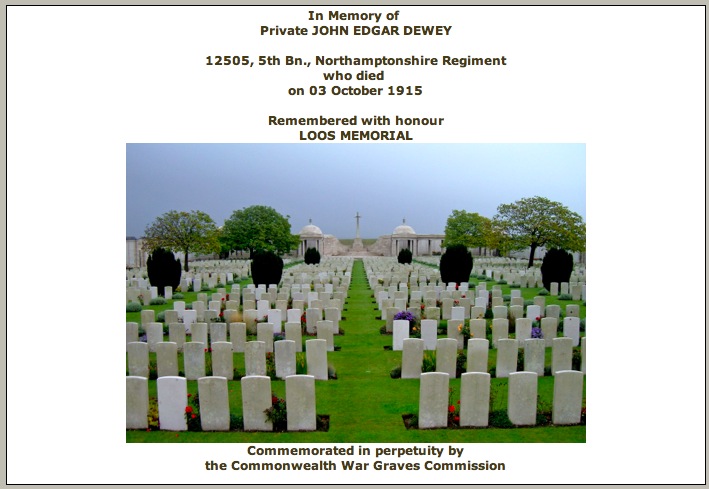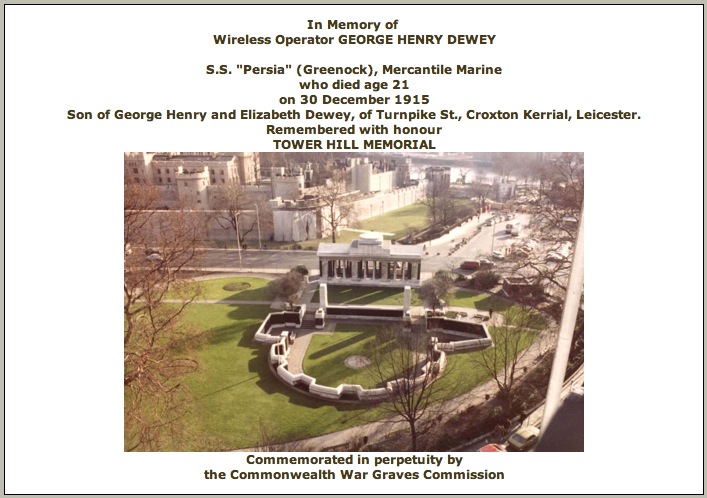Family members killed during the Great War
John Edgar DEWEY
 (link to family tree)
(link to family tree)
 (link to family tree)
(link to family tree)
Son of Charles and Elizabeth DEWEY of Harby, Leicestershire. He was killed in action at Flanders on 3rd October 1915 whilst serving as a Private in the 5th Battalion of the Northamptonshire Regiment.
The Batte of Loos was forced upon the not-quite-ready British by their allies in support of action further along the Western Front (The Third Battle of Artois). History records that despite horrendous casualties, amounting to 50,000 killed or injured, and some typically British cock-ups in communication, Kitchener's army was perilously close to something resembling a victory - before stalling into stalemate.
John Edgar DEWEY was part of the 5th Battalion of the Northamptonshire Regiment, a Pioneer Battalion within the 12th (Eastern) Division. This Division had landed in France on 30th May 1915 and were brought up as part of the reserves after the first advances of the Battle of Loos. They relieved two Brigades of Guards in the Hulluch area, north-east of the captured village of Loos, occupying their positions overnight on 30th September into 1st October.
While they were digging new trenches and preparing to further advance, their positions were subject to relentless shelling, and even the Divisional Commander Major General WING and his Aide-de-Camp Lt. TOWER were killed by shellfire on 2nd October.
John Edgar DEWEY was recorded as being Killed-in-Action on 3rd October 1915. Given the activities of his Battalion at that time, the probability is he was killed by shelling in the area of Hulluch in Northern France.


The youngest son of George and Elizabeth DEWEY of Croxton Kerrial, Leicestershire. He was a Mercantile Marine Wireless Operator on the P&O mail steamer SS Persia, a defensively armed passenger vessel on The Empire Run to India. She left Tilbury on 18 December 1915, via Marseilles on 26 December, bound for Port Said, Aden and Bombay.
She was sunk by the German submarine U-38 commanded by Captain Max Valentiner (an infamous U boat captain, apparently) on 30 December 1915 in the eastern Mediterranean, 71 miles off Crete. The attack occurred at 1.10 p.m., the vessel being struck on the port bow, blowing up the boiler. She sank quickly and 334 of the 501 persons on board were drowned. Four boats got away in safety. Apparently the wreck, which has been recently discovered, contains a wealth of treasure and various salvage expeditions have taken place in the last few years. In 2002 the BBC Timewatch program transmitted a documentary about the Persia, her sinking, and subsequent treasure hunts. The BBC Hampshire web site tells part of the story and some of the artefacts recovered from the wreck are displayed at Beaulieu Maritme Musuem at Bucklers Hard, Hampshire.
 (link to family tree)
(link to family tree)
At Zero Hour on Saturday 1st July 1916, Sjt. THORTON's Battalion were held in reserve as part of the 51st Brigade, 17th Division of XV Corps. Compared with the negligible gains further north, the tactics at the Fricourt Salient were modestly successful. Instead of attacking the fortress village of Fricourt head on, it was to be "pinched out", isolating the defenders. By the time the 7th Lincolns joined the fray at 22:00 on Saturday 1st July, the order had been given to attack Fricourt. However, an arguably over-eager patrol of the South Staffordshire Regiment discovered that the Germans had withdrawn from the village. This is not to underestimate the huge numbers of casualties already sustained to this point.
Even though the Germans had withdrawn from their front line, they were defending the ground in advance of their Second Line without mercy. In addition to 'enfilade' machine gun fire that was said to fill the air with bullets and rip a man to shreds in seconds, the troops also had to endure near constant bombardment by the German artillery. Add to this the constant threat of German snipers and, in the close combat of attacking a defensive trench, the seemingly unlimited supplies of "bombs" (or hand grenades in modern parlance). All-in-all a living hell into which men walked in their thousands.
In my research, I have only found one specific reference to the 7th Battalion of the Lincolnshire Regiment and their action at Fricourt Wood. In the biography of XV Corps Commander, General HORNE (referenced below), describing the action of 2nd July it states; "The aim of the 51st Brigade was now to reach Bottom Wood, but the 7th Lincolns could not make any progress beyond Fricourt Wood".
Evidently the 7th Lincolns did make it through the wood by the next day. Brigadier General FELL was in command of 51st Brigade. On 3rd July his orders were to take Railway Alley, Railway Copse, Crucifix Trench and Bottom Wood. Then, to consolidate in front of Quadrilateral Trench. These features lay to the north-east of the village of Fricourt. FELL reported to General HORNE that he had taken these objectives with the loss of "about 600 men" - of which Sjt. THORNTON was almost certainly one.
[The Silent General - a biography of General Henry Sinclair HORNE by Don Far (Google Books)]

Sjt. John Thomas THORNTON almost certainly met his death in the area of the blue arrow on this trench map. The area of trees at the bottom left is the northern edge of Fricourt Wood, and the objectives of the 51st Brigade on 3rd July are shown here.
Google Maps shows what this area to the north east of Fricourt looks like today. Even accounting for the fact that more than 90 years have passed, it is remarkable how little scarring remains on the landscape given the incredible amount of digging and bombardment which took place all along the Somme front line.
The 7th Lincolns' Battalion war diary is at the National Archives in Kew. This is what it has to say for 3rd July 1916:
WO 2005/97 7th Lincs. War Diary July 1916 (1.7Mb download)
9am In position N of FRICOURT WOOD. Several casualties caused by enemy M.G. [machine gun] fire.
10.50am Lieut. JONES with Btt'n Bombers sent to assist BORDER RGT.
11.40am B Coy under Lieut. CARR sent up to support BORDER RGT, with Lewis guns and bombs.
1.20pm RAILWAY VALLEY taken, S.STAFFORDS sent as reinforcements. Our casualties were - Killed: Capt. L.D.WICKHAM, Lieut. S. SHANKSTER, Lieut. L.C.ANDREWS, 30 O.R. [Other Ranks]. Wounded: Lieut. T.C.BARRETT, Lieut. W I ABBOTT, Lieut. H. EMERY, Lieut. THOMAS, and about 160 O.R. Wounded slightly at duty, Lieut. J KENDALL and Lieut. E de G. CARR. About 1,000 prisoners taken by 51st Brigade. 2 field guns, 2 machine guns and a quantity of stores were captured by the Batt'n.
Again, there is little doubt that Sjt. THORNTON was among the anonymous "30 Other Ranks" killed in the assault on Railway Alley. It is worthy of note that all bar five of the 44 men listed on the 7th Lincs. Roll of Honour as being killed on 3rd July have no known resting place and are instead Commemorated on Thiepval Memorial.
HISTORY OF THE LINCOLNSHIRE REGIMENT
Page 176The next morning [3rd July 1916] at 9 a.m. the three Divisions, 17th, 21st and 34th again attacked the enemy. The weather continued fine, and July 3rd was a bright warm summer day. The Borders and Sherwoods of the 51st Brigade were sent against Railway Alley, and the Lincolnshire and South Staffords against Crucifix Trench, which lay west of and parallel to the road from Fricourt to Contalmaison. There was no barrage which was, possibly, an advantage, as the enemy was not expecting an assault, when the Lincolnshire sent their bombers into the north end of Crucifix Trench from Fricourt Farm. As soon as it was seen that they were in it and bombing down it, the rest of the battalion dashed at it across the open from the Wood, and the South Staffords advanced on their left. The rush was met by a hail of rifle and machine-gun fire, but in spite of casualties, the two battalions poured in over the trench. As the enemy was driven out a number of them were seen trying to escape along a communication trench towards Shelter Wood. The Lincolnshire bombers cut in on their line of retreat, and drove them back into the victorious advance of the Staffords. Thus caught, some hundreds of a Prussian infantry regiment, including their Colonel, surrendered. Early in the afternoon Railway Copse was captured by the Sherwoods, and parties of the South Staffords and Lincolnshire. All the objectives of the 17th Division were won, nearly a thousand prisoners and an immense quantity of stores and material, as well as eleven machine-guns, were taken.
The 7th Battalion had, however, suffered heavy casualties : Captain L.D. Wickham, 2nd Lieutenants S. Shankster and L.C. Andrews and thirty other ranks were killed ; Lieutenants W.I. Abbot and J Kendall and 2nd Lieutenants T.C. Barrett, H. Emery, E.deG. Car and Thomas, and about one hundred and sixty other ranks were wounded or missing. About nine hundred prisoners were taken as well as two field-guns, two machine-guns and a quantity of stores.
The above account of the fighting on the 3rd July is from The History of the 17th Division, by A.H. Atteridge.